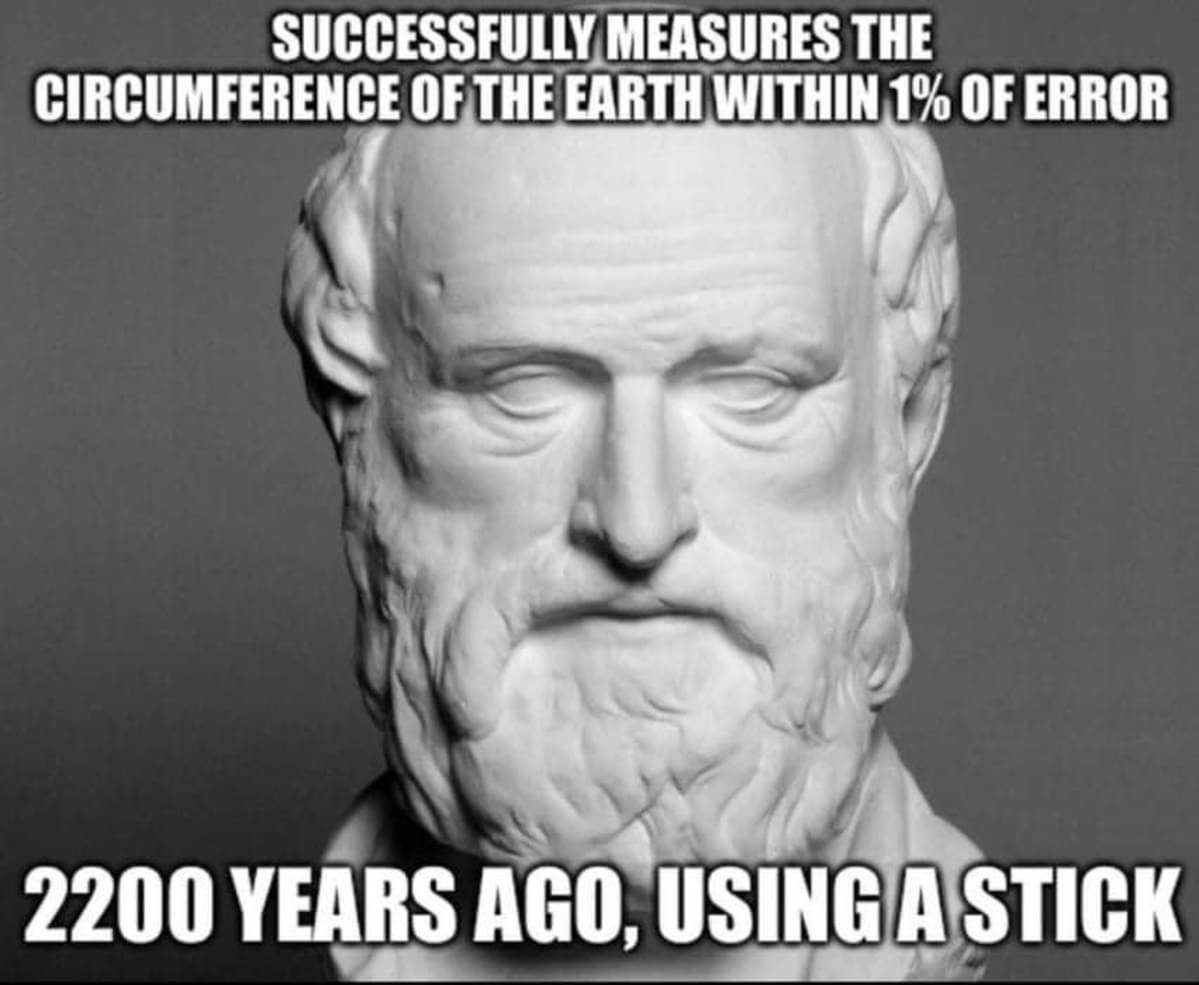When I was a kid my teachers told me that Christopher Columbus discovered the earth was round and that before him everyone thought it was flat. When I was about ~13 I read a short biography of Eratosthenes and it blew my little mind. 
Science Memes
Welcome to c/science_memes @ Mander.xyz!
A place for majestic STEMLORD peacocking, as well as memes about the realities of working in a lab.

Rules
- Don't throw mud. Behave like an intellectual and remember the human.
- Keep it rooted (on topic).
- No spam.
- Infographics welcome, get schooled.
This is a science community. We use the Dawkins definition of meme.
Research Committee
Other Mander Communities
Science and Research
Biology and Life Sciences
- [email protected]
- [email protected]
- [email protected]
- [email protected]
- [email protected]
- [email protected]
- [email protected]
- [email protected]
- [email protected]
- [email protected]
- [email protected]
- [email protected]
- [email protected]
- [email protected]
- [email protected]
- [email protected]
- [email protected]
- [email protected]
- [email protected]
- [email protected]
- [email protected]
- [email protected]
- [email protected]
- [email protected]
- !reptiles and [email protected]
Physical Sciences
- [email protected]
- [email protected]
- [email protected]
- [email protected]
- [email protected]
- [email protected]
- [email protected]
- [email protected]
- [email protected]
Humanities and Social Sciences
Practical and Applied Sciences
- !exercise-and [email protected]
- [email protected]
- !self [email protected]
- [email protected]
- [email protected]
- [email protected]
Memes
Miscellaneous
The accuracy he achieved and in that time period with the information available to him is frankly staggering. The degree of his error is slightly complicated by the stadion not being a historically exact figure, but his calculation showed the Earth to be 252,000 stadia in circumference. Accounting for the variability in the exact length of the stadia dependent on what definition was used in the calculation, that gives us in kilometers 39,060km on the lower end and 40,320km on the upper. The actual circumference of the Earth is 40,075km. This gives him an error range of between -2.4% and +0.8%.
He also didn't just use a stick but used extensive geographic charts to calculate the distance between the 2 cities where he measured the shadow. It was a monumental achievement and is shockingly accurate. I also believe this knowledge was lost to time and for quite a long time after we did not have any measurements even close to this accuracy.
Here is a picture visually demonstrating how he performed his calculation.
It's still seriously impressive with that error range?
Good question
I never said it wasn't. I was originally writing this as a response to a commenter who said the error was ~15%. My comment initially started with "He was actually significantly more accurate than that."
15% commenter here. My number came from the source I used, I'm not enough of a Greek history fan to know one way or the other, thanks for clarifying
Lady Autumn, you have an amazing username. This is great content, thank you so much. My apologies that the comment I replied to looked to me like a top level comment; it still does. I mean no disrespect, and I think we are on the same side?
isnt this the fucker who used units of stadia? The unit that we have no historical reference to? (at least one significant enough to be certain about it's actual referenced distance) Which means that we don't actually know how accurate it was?
Sorta. The stade was based on the pous which varied. But not that much, and in ways that are often consistently documented. Around the time Eratosthenes was alive, give or take a couple hundred years, it was documented that 1 Roman mile = 8 stades, which gives us something to go of off. While there are other possible definitions, we do have one that we know is probably closest to whatever Eratosthenes used.
EDIT - the numbers regarding the error range in this source is likely inaccurate, but goes into the units issue
+/-20% error isn't terrible on a conversion. The fact that it's only 10% offset is crazy though.
I mean we do know the formula, se we know pretty well how accurate it was, since we can just use the same formula with meters and calculate it ourselves
"The simplified method works by considering two cities along the same meridian and measuring both the distance between them and the difference in angles of the shadows cast by the sun on a vertical rod (a gnomon) in each city at noon on the summer solstice. The two cities used were Alexandria and Syene (modern Aswan), and the distance between the cities was measured by professional bematists.[16] A geometric calculation reveals that the circumference of the Earth is the distance between the two cities divided by the difference in shadow angles expressed as a fraction of one turn. "
There were also wells and a lot of walking involved.
2 sticks
THE PYRAMID ALIENS
to be fair it was more than 1 stick
how many sticks then?
A whole bundle of them tied together.
two
Could have been the same stick transported from one place to another.
Also, I thought he used a well?
A well is the inverse of a stick.
Wow. This comment had me thinking DEEP.
Big brain both literally and figuratively based on that etching.
His nickname was "Beta" because he was the second best at everything.
How do you pronounce it? I'm fumbling
"Eratosthenes"
era TOSS the knees
Oi!
'ere, toss da knees, man! We ain't got all day!
Thanks!
Pardon me, did you say "Abe Lincoln"?
Edit: I was trying to reference this: https://www.youtube.com/watch?v=wJcuYKyHEgs
This comment is so underrated; I fucking love that you made it though.
Be over here with my strength of feet.
Achoo!
A Jew‽ Here‽ In England‽
